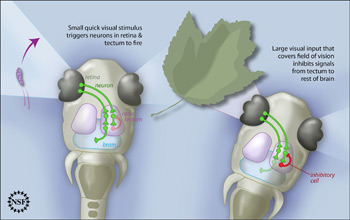News Release 10-205
The Zebrafish's Neural Circuit Prevents It From Biting Off More Than It Can Chew
Inhibiting certain brain cells sharpens animal's response to small and quick visual stimuli

Comparison of neural circuit activated by small quick cue versus large one in zebrafish larvae.
November 1, 2010
This material is available primarily for archival purposes. Telephone numbers or other contact information may be out of date; please see current contact information at media contacts.
Between alerting us to danger and allowing us to spot prey, vision keeps many animals, including humans, alive. But exactly how does this important sense work, and why is it easier for us to spot movement of small objects in our field of vision, than to notice other things? The complexity of the neural network that supports vision has long baffled scientists.
Now, with a new technology and support from the National Science Foundation, Claire Wyart in Ehud Isacoff's lab at the University of California at Berkeley and Filo Del Bene at Herwig Baier's lab at the University of California at San Francisco have been able to follow entire populations of retinal and brain cells in their test animal: the zebrafish larva, and solve some of the mysteries of its neural circuit that underlies its vision.
The research team's findings were published in the October 29 issue of Science.
Using a newly developed genetically encoded fluorescent reporter of neural activity developed by Loren Looger at the Howard Hughes Medical Institute's Janelia Farm Research Campus, Wyart and Del Bene have been able to follow how large and small visual cues translate into electrical activity in a region of the zebrafish's brain.
The brain region of the zebrafish that receives input from the retina, called the optic tectum, is separated into layers. The top layer receives direct connections from retinal cells, and has a population of both excitatory and inhibitory neurons. These neurons connect to output neurons that project to other brain regions that control how the zebrafish chases prey.
Isacoff, Baier, Wyart and Del Bene have revealed that a large visual stimulus covering the entire field of vision (such as large floating debris, or another zebrafish) results in low output neuron activity. However small (prey-sized) items moving across the zebrafish's field of vision at a prey-like speed activate the output neurons very well. The basis of this "filtering" of information is that large visual stimuli massively activate the inhibitory cell population and inhibit the output cells, while small moving objects activate only a small number the inhibitory tectal cells, enabling the excitation to drive the output cells efficiently.
This mechanism gives the zebrafish good hunting responses to appropriate visual cues, and thereby helps keep it from biting off more than it can chew.
Isacoff and Baier demonstrated that the inhibition of neural activity by large visual stimuli is essential for hunting prey--as evidenced by the fact that prey capture was disrupted when the inhibitory cells were removed or prevented from emitting neurotransmitters.
-NSF-
-
The researchers' findings are described in the Oct. 29 issue of the journal Science.
Credit and Larger Version
Media Contacts
Lily Whiteman, The National Science Foundation, (703) 292-8310, email: lwhitema@nsf.gov
Co-Investigators
Ehud Isacoff, University of California at San Francisco, (510) 642-9853, email: ehud@calmail.berkely.edu
The U.S. National Science Foundation propels the nation forward by advancing fundamental research in all fields of science and engineering. NSF supports research and people by providing facilities, instruments and funding to support their ingenuity and sustain the U.S. as a global leader in research and innovation. With a fiscal year 2023 budget of $9.5 billion, NSF funds reach all 50 states through grants to nearly 2,000 colleges, universities and institutions. Each year, NSF receives more than 40,000 competitive proposals and makes about 11,000 new awards. Those awards include support for cooperative research with industry, Arctic and Antarctic research and operations, and U.S. participation in international scientific efforts.
Connect with us online
NSF website: nsf.gov
NSF News: nsf.gov/news
For News Media: nsf.gov/news/newsroom
Statistics: nsf.gov/statistics/
Awards database: nsf.gov/awardsearch/
Follow us on social
Twitter: twitter.com/NSF
Facebook: facebook.com/US.NSF
Instagram: instagram.com/nsfgov



